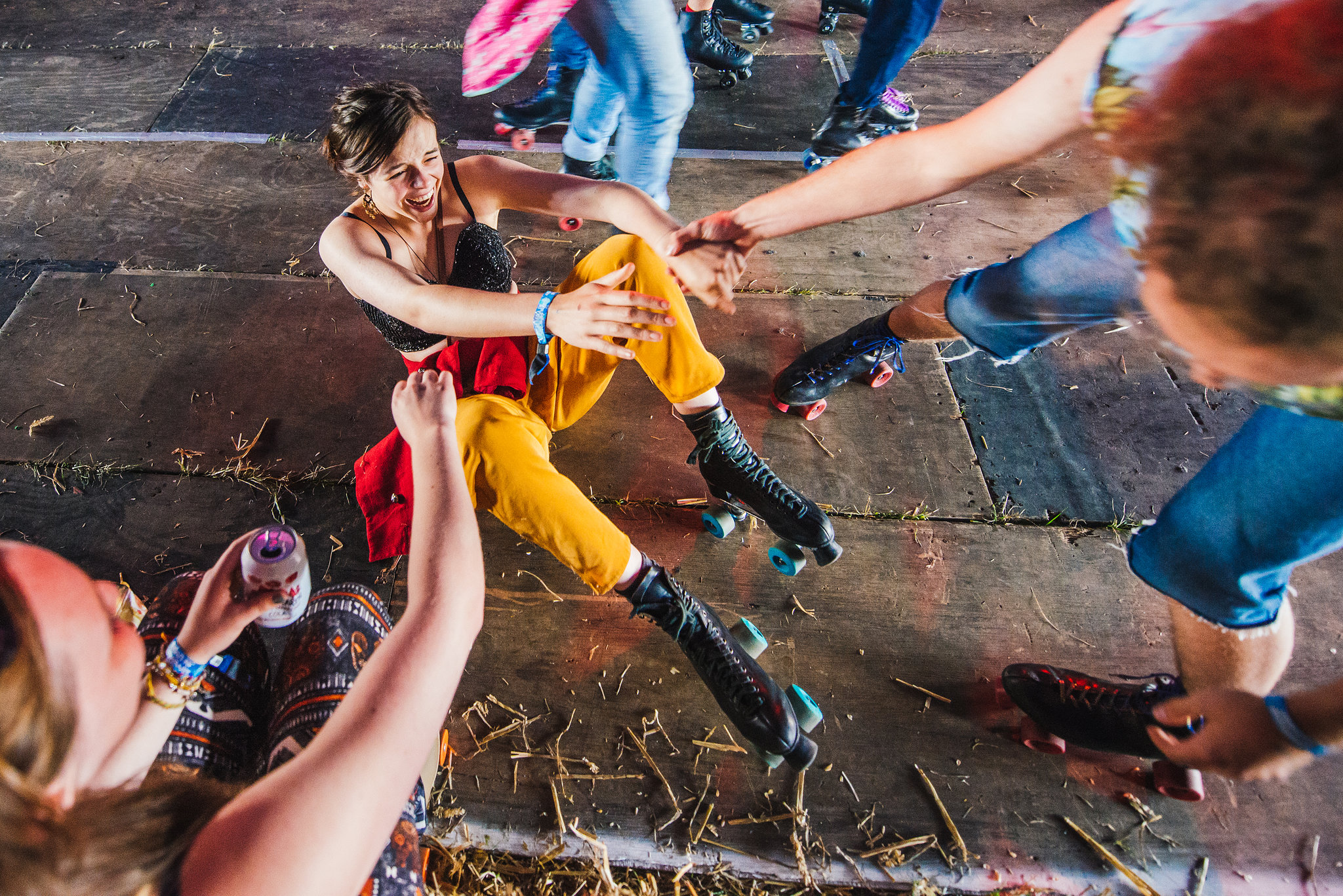Health and Safety Information & Safe Working Practices for Contractors and Event Personnel
INTRODUCTION
Because the physical safety of people working on our event is of paramount importance the general safety systems detailed in this document have been produced to provide a set of instructions for safe working. This is in order to prevent any undue risk to yourself, other staff, contractors and members of the public.
On arrival at the site, all event staff will be provided with a safety information card. This will outline general site rules and emergency contacts. Everyone working or volunteering onsite MUST know:
- How to get help in an emergency
- Where to find first aid
- What to do in the event of a fire/evacuation
- Where to find basic rest/welfare facilities
All managers must carry out a short briefing with their teams to ensure that everyone understands the site rules. There may be additional specific safe working methods and procedures for your particular area of work determined by your employer or provider of equipment, and you should ensure that these are followed.
Who does this guide apply to?
The guide applies to everyone engaged in the creation and delivery of our event; from the directors to suppliers delivering equipment, regardless of their employment status. The aim is to foster a safe working environment for all involved.
SITE SAFETY RULES
General Safety:
- Crew and contractors must report to the Site Office before commencing work onsite.
- Hi-Viz vests will be mandatory wear during build and break days.
- All staff are required to use the appropriate PPE for the task. This particularly applies to chainsaw use where full protection must be worn without exception. PPE requirements may change as areas of the site are completed and major site risks reduced.
- Any accident or incident must be reported immediately to the Site Office, or Event Control, who will notify the Safety Team.
- Good housekeeping is essential. Keep your work area tidy and dispose of waste properly in bins. Try and separate waste for recycling. Do not allow any flammable material to accumulate.
- Fire exit routes should not be blocked at any time, both inside and outside venues
- Smokers should smoke in designated smoking areas and dispose of their cigarette butts responsibly.
- Make sure you have enough light to see what you are doing. Please ask Site Office in advance if you feel your work area is insufficiently lit for the tasks you need to complete, and your work is likely to extend into hours of darkness.
- All contractors should follow their methods statements and risk assessments specified for the work they are carrying out.
- All staff and contractors must not work under the influence of alcohol or drugs. Anyone deemed to be not fit for work will be asked to leave the venue.
- Any staff welfare concerns should be raised with the Event Office. A member of the event site team will be available at any time to discuss any issues relating to staff welfare or other concerns on safe working.
Driving Onsite:
- DRIVE SLOWLY. The site speed limit is 10 mph.
- Vehicle movement is not permitted from 9pm- 6am anywhere onsite throughout the build and break, unless expressly authorised.
- Do not use hazard lights on site as this can cause confusion to pedestrians.
- Watch out for pedestrians, especially, children at all times. Use a banksman when reversing.
- Do not use phones or radios when driving unless you have a proper hands-free device.
- Keep to tracks and roadways. Avoid driving on the grass where you can. Special attention must be paid to prevent damage to the ground, tree branches or roots.
- If the ground conditions are particularly bad, all driving onsite will be suspended.
- Where your work area may present a risk to others you should create a safe working area using barriers, tape or signage as necessary.
Task Specific:
- Any work at height, even at low levels must be carried out safely. Steps and ladders are for short-term work, must be secure and particular care taken to avoid over-reaching or leaning. Ladders should always be footed by a second person.
- Scaffold towers must be correctly built and sited on firm level ground as far as possible and are preferred to ladders.
- Use of any plant equipment is restricted to authorised users only. User tickets must be registered with the site office before any keys are provided. Users must be fit and alert when using any heavy machinery and work with a banksman as far as possible.
- Take note of any identified overhead hazards or height restrictions. For example, cables flown on goalposts or tree branches.
- Electrical work can only be undertaken when supplies have been confirmed as safe and ready for use. Live electrical work is not permitted without a permit to work and can only be undertaken by a competent qualified person.
- Any work involving ‘hot work’ such as welding or grinding, or any work with gas or liquid fuels should be undertaken with due regard to fire safety. Please discuss this work with the safety team. Oxy-Acetylene is not permitted.
- To avoid slips, trips and falls: Be aware of your environment: incomplete stage sections or scaffold structures, or flooring sections, handrails etc. Ensure any spillages and waste materials are cleared up as soon as possible and that materials are stacked or stored safely. Use pedestrian routes or any barriered or signed safe working areas where they have been created.
- Hazardous substances: these must be stored appropriately; care should be taken with some glues or spray paints to ensure the area is well ventilated. Appropriate protective equipment should be used.
- Any flammable substances or materials brought onto site should be notified to the safety team and any special instructions for use provided by the supplier should be followed.
- Manual Handling: avoid manual handling where possible with the use of equipment such as forklift trucks. Ideally, carry out unloading of trucks and general installation work in the hours of daylight, or request additional lighting, if needed. Where no mechanical lifting equipment is available, plan lifts to minimise the physical impact, including using multiple people to lift, ensure routes are clear and be mindful of posture and avoid twisting. Wear gloves to avoid lacerations.
- Noise: protect yourself from over-exposure to noise. Minimise your time in the high noise area; reduce the noise level if possible; maximise your distance from the source. Use hearing protection whenever the noise is loud. Earplugs available at the Site Office and Event Control Office
- Only use equipment you are trained and competent to use. Do not bypass, modify or remove any safety guards or devices from equipment.
- Structures must be built according to the manufacturer’s design or approved drawings and meet the requirements of IStructE guidance ‘Temporary Demountable Structures’.
- All structures with elevated working platforms must be fitted with guard rails to prevent falls from height.
- Stage edges should be highlighted and where possible demarcated with a temporary barrier, ratchet strap or hazard tape line during the construction period.
- Suppliers of structures must provide a certificate of completion to the Event Office
- Rigging and lifting: all installations must be secure and stable. Where equipment is flown above audience members then secondary safety bonds should be considered.
- No crew member, other than those people designated by the rigging team, shall operate any lift motor or winch system. Motor controls should be isolated or disconnected when not in use.
- Safe working areas should be demarcated or barriered where necessary and appropriate PPE worn when working beneath or near lifting operations.
IN THE EVENT OF AN ACCIDENT, INCIDENT or EMERGENCY (medical, infrastructure, security and other)
Staff and contractors must report All emergencies, accidents, incidents and near-misses to the Site Office / Event Control, and follow the directions given.
Actions to take:
- Make the area safe from ongoing hazards
- Assess the situation
- Report to the Site Office / Event Control, informing them of the nature of the incident, exact location, and assistance required (before trying to deal with the issue)
- If qualified and confident to do so, deal with the incident – i.e. administer first aid; use a fire extinguisher, or wait for assistance to arrive (keeping the area clear of bystanders)
- When the incident has been dealt with, complete an incident report with the Site Office or Event Control.
If the incident is sufficiently serious, the Event Management Team will initiate emergency action and may include the evacuation of part or all of the event site. In the event of the incident requiring full evacuation, the appropriate emergency services shall be contacted via 999 by the Site Office / Event Control.
IN THE EVENT OF A MEDICAL EMERGENCY
Actions to take if an accident or injury occurs
- Make sure no one else is in any immediate danger (including yourself), i.e. from electric shock, traffic, falling objects
- Do not move the casualty unless they are in further danger
- Call for first aid assistance via Event Control or the Site Office, by radio or telephone – contacts on the front of this card. They will call 999 if required.
- Offer emergency first aid, if competent and confident to do so.
THE NEAREST A&E FACILITY IS:
Kettering General Hospital
Rothwell Rd, Kettering,
NN16 8UZ
OR
Northampton General
Cliftonville, Northampton,
NN1 5BD
IN THE EVENT OF FIRE
- Raise the alarm – by shouting FIRE to those in the immediate area and contacting Event Control (live show) or the Site Office (Build & Break). They will call 999 if required.
- Where safe and you feel confident to do so, you can attempt to tackle the fire using the appropriate fire fighting equipment available around the site.
- If it is necessary, EVACUATE the area, and assist others if safe to do so.
- Don’t return to the area until you are advised that it is safe to do so.
OTHER INCIDENTS
Notify Event Control or Site Office of any incidents you may notice such as broken fencing, toilet leaks, gas leaks, or any other potential safety hazards.
If you witness actual or potential disorder do not put yourself at risk. Notify event control or a steward/security immediately. Clear the area of vulnerable bystanders and potential weapons and await assistance from security.
SITE RULES SUPPORTING INFORMATION
CONTRACTORS AND FREELANCERS
The event will clearly involve the use of various contractors and freelance personnel, some of whom may have their own health and safety policies and method statements for carrying out particular work operations. The information given within this document is intended to complement and not replace any existing contracted company policy and should be seen as a statement of overall safety strategy for the event.
ALCOHOL AND DRUGS
Drugs and alcohol affect an individual’s ability to perceive problems and work safely. Any staff found to be working under the influence of alcohol or non-prescription drugs will be required to stop work and asked to leave the site.
WORKING HOURS
You should not work beyond a point where it is safe, or when your ability to concentrate is compromised. If you have concerns over your own state of fatigue or that of a colleague, raise this with your manager or the Site Office/ Event Control.
ACCIDENTS & INCIDENTS
All contractors should nominate an individual to be responsible for first aid for their own staff. A first aid box will be available in the Site Office/ Event Control, and suitably qualified first aiders will be identified from amongst the event team to assist where necessary.
All accidents and any near-miss incidents MUST be reported to the Site Office/Event Control and an appropriate entry made in the log or accident book. The Safety Team will be notified where necessary.
STAFF WELFARE AND CONSULTATION
It is the intention of the event to ensure that all working personnel have access to suitable washing and sanitary facilities. Personnel are asked to maintain a good level of personal hygiene and hand washing and to leave facilities as clean and usable for everyone.
Any concerns around staff welfare or safe working concerns should be raised to the Site Office or Event Control. A member of the event team will be available at any time to discuss any issues relating to staff welfare or other concerns on safe working.
CHILDREN AND VULNERABLE ADULTS
Children are to be supervised at all times during the build and break periods of the event. All personnel are reminded to be aware of the possible presence of children in their working areas and should report any problems to the Site Office/ Event Control.
GENERAL HOUSEKEEPING
Untidiness in the workplace can be the cause of minor and major accidents. Good housekeeping is essential.
Work must be organised such that traffic routes, exits and pedestrian walkways are not compromised. Storage areas for empty stillages and unused materials will be identified by Site Management.
Make sure empty flight cases are sensibly stashed (with butterfly catches done up), cables don’t run over walkways where they can be tripped over or damaged by vehicles and so on.
Dispose of all waste materials in bins; this includes broken cable ties, food waste or packaging, empty drinks bottles and used gaffa tape balls.
Smokers should use the sand buckets located around the site for disposing of cigarette ends. Please do not use these buckets for other waste. Please do not litter the ground with fag butts.
PERSONAL PROTECTIVE EQUIPMENT
All event personnel will be expected to use appropriate PPE when a relevant hazard is present.
You must have the right equipment and clothing to do the job before you start work.
The following general rules for PPE apply:
- Steel toe shoes or boots are required for all manual handling work. Enclosed footwear is a minimum requirement for any other work activity. Sandals and flip-flops are not acceptable.
- Hard hats must be worn when there is a risk of injury from falling materials or equipment. Climbing helmets with chin strap are recommended for those required to work at height.
- Hi-Viz jackets/vest are generally required when working with or near vehicles in reduced lighting levels.
- Full fall-arrest and fall prevention systems for anyone carrying out work at height
- Hearing protection is required for all personnel working with noisy work equipment or in close proximity to PA and sound systems.
PPE must be properly looked after and worn correctly. Failure to use PPE properly or at the appropriate time will be considered a serious breach of Event Policy.
FIRE SAFETY
All personnel should make themselves familiar with exit routes, the method of raising the alarm and the location of any fire-fighting equipment.
Any contractor needing to undertake any sort of ‘hot work’ (grinding, welding, metal cutting etc) will be required to notify the Site Office or Event Control in advance to identify the precautions required to prevent any outbreak of fire. Consultation with the
Safety Team may be required.
All personnel should ensure that work areas or kept tidy and waste removed to bins or skips.
Any flammable substances or materials brought onto site should be notified to the Site Office or Event Control, and any special instructions for use provided by the supplier should be followed. Please note that Oxy-Acetylene is not permitted onsite due to the volatility of the fuel and the potential risks to the entire show that it can present.
Smoking is only permitted in designated smoking areas. No smoking is permitted in any enclosed structure. Smoking materials should be disposed of carefully.
Fire exit routes should be maintained as clear at all times both inside and outside venues or enclosed structures.
Guidance on fire safety planning for venues and art projects is provided in a separate document and includes consideration of venue layout, choice of materials used for décor, designing exit routes and determining capacities.
ELECTRICAL SYSTEMS AND MAINS CONNECTION
All electrical equipment provided for use on the site must be fit for purpose and in a good state of repair. Regular inspection and testing of all equipment is required and where applicable a certificate of Portable Appliance Test (PAT) conformity should be readily available.
It is the responsibility of the on-site electricians to make mains connections. No electrical equipment should be connected unless and until they have deemed it safe to do so. Distribution boxes and other supply points shall only be provided by the accredited electricians.
No item of electrical equipment should be plugged into the electrical system unless it has been subjected to a simple visual inspection and is in safe condition. Connection of equipment that looks damaged or in poor condition must be avoided.
If faulty equipment is identified by site electricians, they will be required to refuse connection until fixed or removed from site.
Electrical installations shall meet the requirements of BS7909/BS7671 as appropriate, and the certificate of completion provided to the site safety team for each separate installation.
Portable personal generators are actively discouraged and should only be used in consultation with the Site Office or Event Control.
SLIPS, TRIPS AND FALLS
Be aware of your environment and avoid becoming distracted by phone calls, texts and IM’s. Take particular care at the edges of any platforms, ramps, steps and treads or on uneven ground. Be aware of any incomplete stage sections or scaffold structures.
Report any problems with the stability or security of any stage or flooring sections, handrails and so on.
Ensure any spillages and waste materials are cleared up as soon as possible and that materials are stacked or stored safely.
Please take notice of and use pedestrian routes or any barriered or signed safe working areas where they have been created.
Ensure tent pegs or other projections from the ground are properly clad or highlighted.
Due to the nature of the event site, it is possible that some areas will be affected by very low lighting levels, especially at night. Any specific hazards should be reported to the Site Office or Event Control.
SUBSTANCES HAZARDOUS TO HEALTH
Certain substances can be harmful and can cause irritation when coming into contact with skin or eyes or more serious damage if inhaled or ingested. Care should be taken with some glues or spray paints to ensure the area is well ventilated. Appropriate protective equipment should be used, and hazardous substances should be stored appropriately.
If you are in any doubt about a chemical or substance being used, please consult the Site Office or Event Control.
MANUAL HANDLING
Ideally, carry out unloading of trucks and general installation work in the hours of daylight, or request additional lighting, if needed.
TAKE CARE OF YOUR BACK – IT IS A VERY DELICATE STRUCTURE.
The following steps can be taken to reduce the risk of injury.
- Avoid the work where possible and use a mechanical means.
- Reduce the weight of the load you have to handle. Make the load smaller or easier to lift; for example, by splitting cases into more manageable components if possible.
- Plan the lift, clear your route and make sure you can see over the load you are carrying.
- Look out for sharp edges, projections, splinters etc. Loads may be hot or very cold. Wear gloves as appropriate.
- Modify the work to reduce carrying distances, twisting movements, or lifting things from floor level or above shoulder height.
- Get help if the load is awkward or heavy, do not struggle alone.
- Make sure that everyone involved in ‘team lifting’ tasks is working to the same plan or count.
NOISE
The event is determined to minimise the danger posed to staff by loud noise and will enact measures to control exposure – either from sound systems or other sources. If your job requires you to work in a loud environment, you should take simple steps to protect yourself from long-term damage:
- Minimise your time in the high noise area
- Reduce the noise level if possible
- Maximise your distance from the source
- Use hearing protection whenever the noise is loud
It is likely that some safety critical tasks or communications will be compromised by noisy environments and work should be planned to temporarily suspend such work until communication is easier. For example, work involving the movement of plant where reversing warnings may not be heard.
WORKING WITH HAND AND POWER TOOLS
Only use equipment you are trained and competent to use. Do not bypass, modify or remove any safety guards or devices from equipment. All tools used should be suitable for the task at hand. Use PPE where required.
Anyone using disc cutters, grinders or similar work equipment must be properly trained and must use the relevant protective equipment.
Users of chainsaws must use full protective equipment including a visor, hearing protection, proper footwear and ballistic clothing. Fuel must be stored safely and a working area created to prevent access by personnel not involved in the operation of the equipment.
Electrically powered tools should ideally be battery or 110V supplied. Where 240V tools are used they must be fitted with a residual current device (RCD).
WORKING WITH VEHICLES AND PLANT
Site speed limit is 10 mph. Do not use hazard lights on site as this can cause confusion to pedestrians.
All vehicles must use identified traffic routes and roadways within the site. Any staff or contractors working close to vehicles should wear a hi-viz jacket or vest to aid visibility (especially at night). Staff working at traffic gates or near public highways must wear hi-viz at all times.
Plant such as forklifts, telehandlers, cherry pickers, scissor lifts and cranes can only be operated by duly accredited personnel. Evidence of training/competence is required in all cases. For personnel operating a logbook, the Site Office will be happy to sign off hours.
Use of cranes will be by ‘contract lift’ arrangement only. Contact the Site Office or Event Control for more information.
The use of mancages shall be strictly controlled and only permitted under exceptional circumstances where no other means of access is possible or appropriate. Please contact the Site Office/ Event Control.
All goods vehicles must have their vehicle height clearly marked in the cab, and if in doubt of height clearance, should be seen onto the site by a competent person from the event team.
Drivers of delivery vehicles should be on hand to supervise the unloading of equipment to identify where loads may have shifted in transit or where releasing of straps may cause loads to become unstable.
When working with vehicles or plant machinery ensure that all movements are guided or directed by a banksman.
Where a tail lift is in use it shall only be operated by a competent person, who will also ensure that personnel unfamiliar with the operation of the tail lift keep hands and feet clear. The tail lift will be either closed or lowered flat to the ground when not in use and will be isolated to prevent improper use. Be aware that metal surfaces such as tail lifts, ramps, steps and stairs can be very slippery in wet conditions and can also be a trip hazard.
All plant must be supplied in a condition that is fit for use and operators are expected to conduct daily checks of fuel and oil levels and operation of lights and safety devices. All warning devices must be operable.
Telehandlers and all other lifting plant should be used within the capabilities of the machine using outriggers and other stability devices where necessary. For any complex lifting issues please contact the Site Office or Event Control.
Passengers must not be carried on any plant unless there is a dedicated seat for them. Riding on footplates or standing on trailers is prohibited.
Keys must not be left in unattended plant or site vehicles and vehicles should not be parked such that they block access routes.
STRUCTURES
The event will use a number of different temporary structures from tents and marquees to custom-designed stages and scaffolds.
All structures must be built according to the manufacturer’s design or approved drawings and meet the requirements of IStructE guidance ‘Temporary Demountable Structures’.
Wind-loading calculations are required for all structures that may be affected by wind and weather conditions. These will be added to the weather action plan held at Event
Control and should conditions require temporary closure then this call shall be made as necessary. All stages and marquees should be able to withstand 25m/sec as a minimum.
Attachments to structures such as scenic cladding, signage or other elements that may affect its performance in the wind should be agreed in advance with the structure supplier or the events structural engineer to ensure that the appropriate ballast or underpinning is in place.
All structures with elevated working platforms must be fitted with guard rails to prevent falls from height. Stage edges should be highlighted and where possible demarcated with a temporary barrier, ratchet strap or hazard tape line during the construction period.
Suppliers of structures must provide a certificate of completion to the Site Office, stating that it has been built according to the appropriate design and that it is stable and ready for use. These statements should identify any limitations on the structure in terms of applied loadings from AV or scenic installations and a maximum operating windspeed.
RIGGING AND LIFTING
All lifting operations must be planned and assessed prior to any lift being carried out. This includes checking for overhead hazards, ground conditions or other limitations on the task.
All equipment used for rigging or lifting must be appropriate for the task, used with its safe working load, and where required formally inspected and tested. Any damaged or unsuitable accessories must be removed from service.
Attachments of loads such as lighting trusses or scenic elements to structures must be approved and agreed with the structure supplier.
All installations must be secure and stable. Where equipment is flown above audience members then secondary safety bonds should be considered.
No crew member, other than those people designated by the rigging team, shall operate any lift motor or winch system. Motor controls should be isolated or disconnected when not in use.
There must be rigorous and absolute control over the mechanisms for lifting truss/screens/stage elements and so on.
Safe working areas should be demarcated or barriered where necessary and appropriate PPE worn when working beneath or near lifting operations.
A strict system must be adopted to ensure that any element is safe to move prior to activation of the controls. This must include:
- Avoiding motor movements without the knowledge of the appropriate HoD or technician
- Visual check to ensure path of load is free of obstruction
- Clearance of all non‐essential personnel
- Disconnection of safety system/secondary suspension
- Clear and audible warning of “truss in motion”, “screen moving” etc. prior to operation
Specialist rigs for performer flying, tightropes or other circus-style rigs must be designed and installed by a competent operator and where possible tested with a dummy load prior to first use. Frequent checks must be undertaken to ensure that the set-up remains intact and that all carabiners and clips are properly engaged and moused where necessary.
EXCAVATIONS AND CONFINED SPACES
It is possible that some installations may require excavation of the ground to facilitate it. All practical steps must be taken to prevent the collapse of excavations and ensure the safety of workers from falls into excavations. It should be noted that the use of hazard tape may not always be sufficient and a physical barrier may be required.
Any digging to depths of more than 750mm should be advised to the Site Office and arrangements made to shore up the sides or batter the edges of the excavation.
Advice must be sought from the Site Manager prior to digging to ensure that no buried service will be damaged.
Art projects that include confined spaces should be planned to ensure that the public can be rescued easily if necessary and that the area cannot be subject to depletion or displacement of air.
Any work adjacent to, or working over water presents a risk of drowning, and any work in these areas should be notified to the Site Office or Event Control. Lone working on or near open water must be avoided. Where work on or adjacent to water is required then staff should use a life jacket or floatation aid. Rescue rings should be available.
Lifeguards will be on duty during public opening period.
Only water outlets marked “DRINKING WATER”, are safe to drink.
Please contact the Site Office or Event Control if you have any questions.
Ear plugs available at the Event Office. [NC1]






